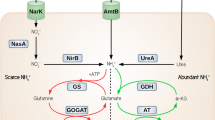Abstract
Streptomyces and related bacteria produce a wide variety of secondary metabolites. Of these, many compounds have industrial applications, but the question of why this group of microorganism produces such various kinds of biologically active substances has not yet been clearly answered. Here, we overview the results from our studies on the novel function and role of Streptomyces metabolites. The diverged action of negative and positive influences onto the physiology of various microorganisms infers the occurrence of complex microbial interactions due to the effect of small molecules produced by Streptomyces. The interactions may serve as a basis for the constitution of biological community.


Similar content being viewed by others
References
Amano S, Morota T, Kano YK et al (2010) Promomycin, a polyether promoting antibiotic production in Streptomyces spp. J Antibiot 63:486–491
Amano SI, Sakurai T, Endo K et al (2011) A cryptic antibiotic triggered by monensin. J Antibiot 64:703
Buchholz K, Collins J (2013) The roots—a short history of industrial microbiology and biotechnology. Appl Microbiol Biotechnol 97:3747–3762
Chater KF (2006) Streptomyces inside-out: a new perspective on the bacteria that provide us with antibiotics. Philos Trans R Soc Lond B Biol Sci 361:761–768
Davies J (2006) Are antibiotics naturally antibiotics? J Ind Microbiol Biotechnol 33:496–499
Eto D, Watanabe K, Saeki H et al (2013) Divergent effects of desferrioxamine on bacterial growth and characteristics. J Antibiot 66:199–203
Fujimoto M, Yamada A, Kurosawa J, Kawata A, Beppu T, Takano H, Ueda K (2012) Pleiotropic role of the Sco1/SenC family copper chaperone in the physiology of Streptomyces. Microb Biotechnol 5:477–488
Gunter K, Toupet C, Schupp T (1993) Characterization of an iron-regulated promoter involved in desferrioxamine B synthesis in Streptomyces pilosus: repressor-binding site and homology to the diphtheria toxin gene promoter. J Bacteriol 175:3295–3302
Hara O, Beppu T (1982) Induction of streptomycin-inactivating enzyme by A-factor in Streptomyces griseus. J Antibiot 35:1208–1215
Horinouchi S (2007) Mining and polishing of the treasure trove in the bacterial genus Streptomyces. Biosci Biotechnol Biochem 71:283–299
Khokhlov AS, Tovarova II, Borisova LN et al (1967) The A-factor, responsible for streptomycin biosynthesis by mutant strains of actinomyces streptomycini. Dokl Akad Nauk SSSR 177:232–235
Klotz LO, Hou X, Jacob C (2014) 1,4-naphthoquinones: from oxidative damage to cellular and inter-cellular signaling. Molecules 19:14902–14918
Martens JH, Barg H, Warren MJ, Jahn D (2002) Microbial production of vitamin B12. Appl Microbiol Biotechnol 58:275–285
Meng L, Li M, Yang SH, Kim TJ, Suh JW (2011) Intracellular ATP levels affect secondary metabolite production in Streptomyces spp. Biosci Biotechnol Biochem 75:1576–1581
Mitani M, Ohtake N (1978) Studies on the ionophorous antibiotics. XVI. The ionophore-mediated calcium transport and concomitant osmotic swelling of mitochondria. J Antibiot 31:888–893
Nishiyama T, Hashimoto Y, Kusakabe H, Kumano T, Kobayashi M (2014) Natural low-molecular mass organic compounds with oxidase activity as organocatalysts. Proc Natl Acad Sci USA 111:17152–17157
Perlman D (1959) Microbial synthesis of cobamides. Adv Appl Microbiol 1:87–122
Takano E (2006) Gamma-butyrolactones: Streptomyces signalling molecules regulating antibiotic production and differentiation. Curr Opin Microbiol 9:287–294
Takano H, Beppu T, Ueda K (2006) The CarA/LitR-family transcriptional regulator: its possible role as a photosensor and wide distribution in non-phototrophic bacteria. Biosci Biotechnol Biochem 70:2320–2324
Takano H, Hagiwara K, Ueda K (2015) Fundamental role of cobalamin biosynthesis in the developmental growth of Streptomyces coelicolor A3(2). Appl Microbiol Biotechnol 99:2329–2337
Takano H, Mise K, Hagiwara K, Hirata N, Watanabe S, Toriyabe M, Shiratori-Takano H, Ueda K (2015) The role and function of LitR, an AdoB12-bound light-sensitive regulator of Bacillus megaterium QM B1551, in the regulation of carotenoid production. J Bacteriol 197:2301–2315
Takano H, Obitsu S, Beppu T, Ueda K (2005) Light-induced carotenogenesis in Streptomyces coelicolor A3(2): identification of an extracytoplasmic function sigma factor that directs photodependent transcription of the carotenoid biosynthesis gene cluster. J Bacteriol 187:1825–1832
Ueda K, Kawai S, Ogawa H, Kiyama A, Kubota T, Kawanobe H, Beppu T (2000) Wide distribution of interspecific stimulatory events on antibiotic production and sporulation among Streptomyces species. J Antibiot 53:979–982
Yamanaka K, Oikawa H, Ogawa HO, Hosono K, Shinmachi F, Takano H, Sakuda S, Beppu T, Ueda K (2005) Desferrioxamine E produced by Streptomyces griseus stimulates growth and development of Streptomyces tanashiensis. Microbiology 151:2899–2905
Author information
Authors and Affiliations
Corresponding authors
Additional information
Special Issue: Natural Product Discovery and Development in the Genomic Era. Dedicated to Professor Satoshi Ōmura for his numerous contributions to the field of natural products.
Rights and permissions
About this article
Cite this article
Takano, H., Nishiyama, T., Amano, Si. et al. Streptomyces metabolites in divergent microbial interactions. J Ind Microbiol Biotechnol 43, 143–148 (2016). https://doi.org/10.1007/s10295-015-1680-z
Received:
Accepted:
Published:
Issue Date:
DOI: https://doi.org/10.1007/s10295-015-1680-z




